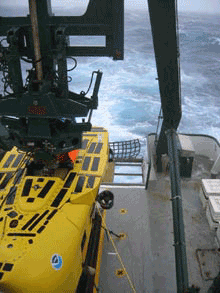 Sequence
of waves that hit the stern of the KoK during
one of the recent storms that the vessel has endured.
Sequence
of waves that hit the stern of the KoK during
one of the recent storms that the vessel has endured.
![]() Click
image to view a slide show
Click
image to view a slide show
Waiting out the storm
May 5, 2005
Bob Embley
Co-Chief Scientist for the New Zealand American Submarine Ring of Fire Expedition
(Legs 1 and 2)
Geophysicist
NOAA Vents Program, Pacific Marine Environmental Laboratory – Newport,
Oregon
The KoK is like a ghost ship. Most of the science team, and anyone not on watch, are hunkered down waiting this storm out. We've been butted by 40 knot winds all day, with gusts topping 60 knots earlier. Some damage has incurred. One of the gratings has been blown off the submersible “tailgate” and the large hanger door holding the Pisces IV submersible was stuck in closed position after a large wave smashed into it.
The front of the storm passed us yesterday, leaving just enough time to recover the 3 long current meter moorings deployed near Brothers Volcano before the rest of it hit us early this morning. Today we are holding position into the wind and waiting it out. Hopefully by tomorrow we'll be operational again. The other surprise is that the volcanic cones are composed of basalt, instead of the rhyolite that makes up much of the older caldera. The type of magma being generated beneath the volcano has switched from a high-silica - "sticky" - magma to lower silica, less viscous basaltic lava. Why is this and how does it relate to the iron-rich venting discovered here? We don't know the answer to this question, although there are some spirited discussions among the science team on board. In any case, surprises like this are what moves science ahead to a new understanding of how these volcanoes work.
Sign up for the Ocean Explorer E-mail Update List.


























